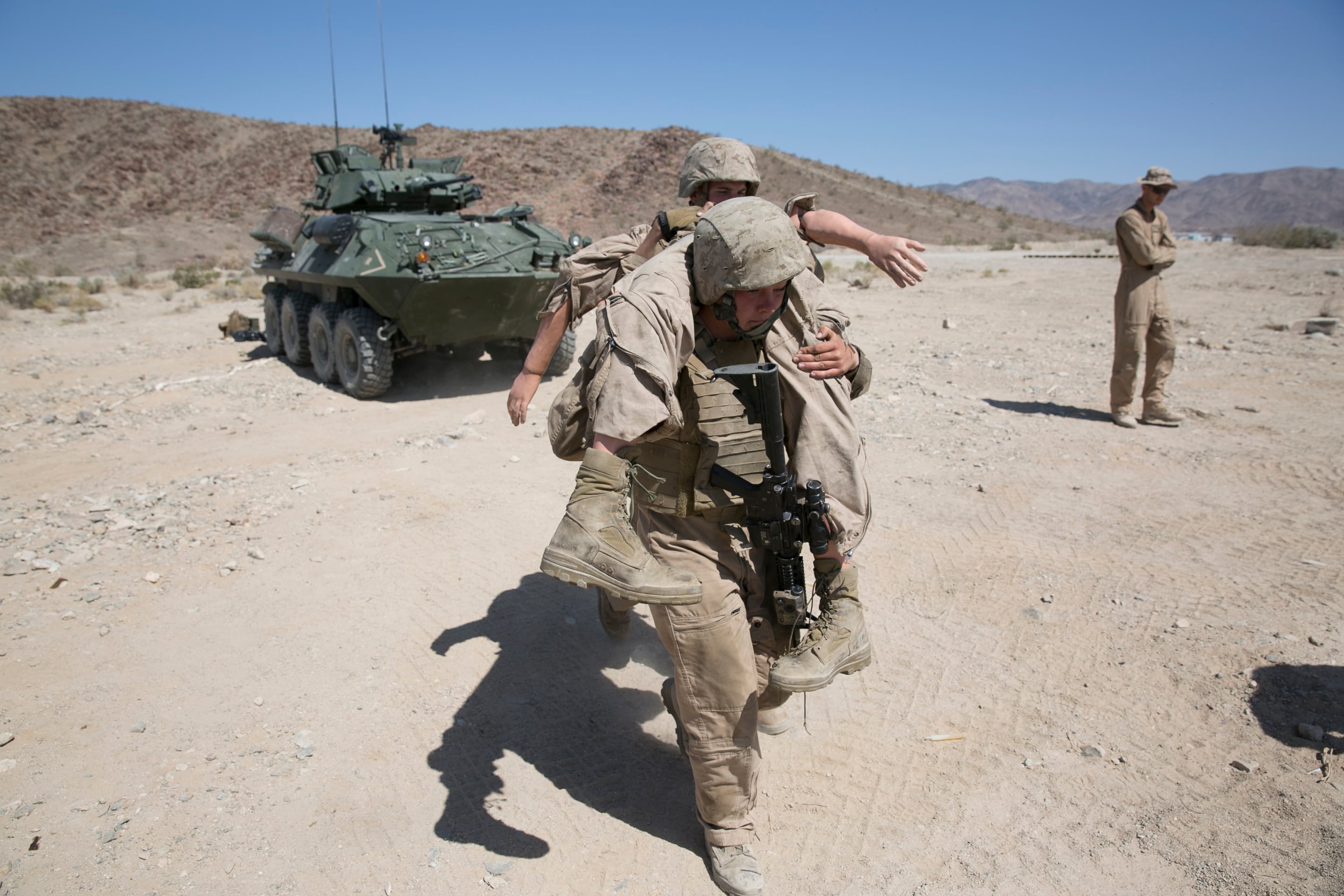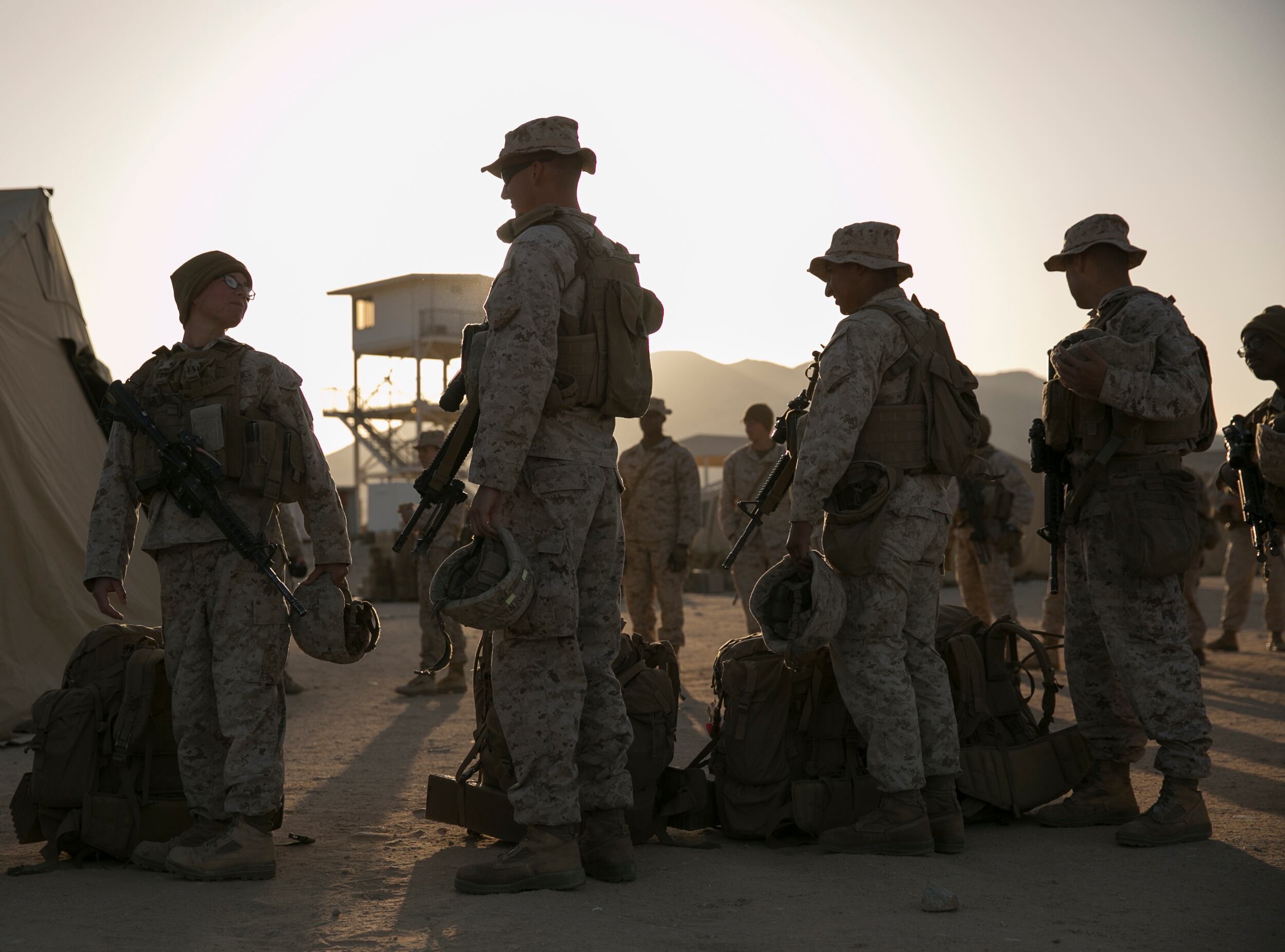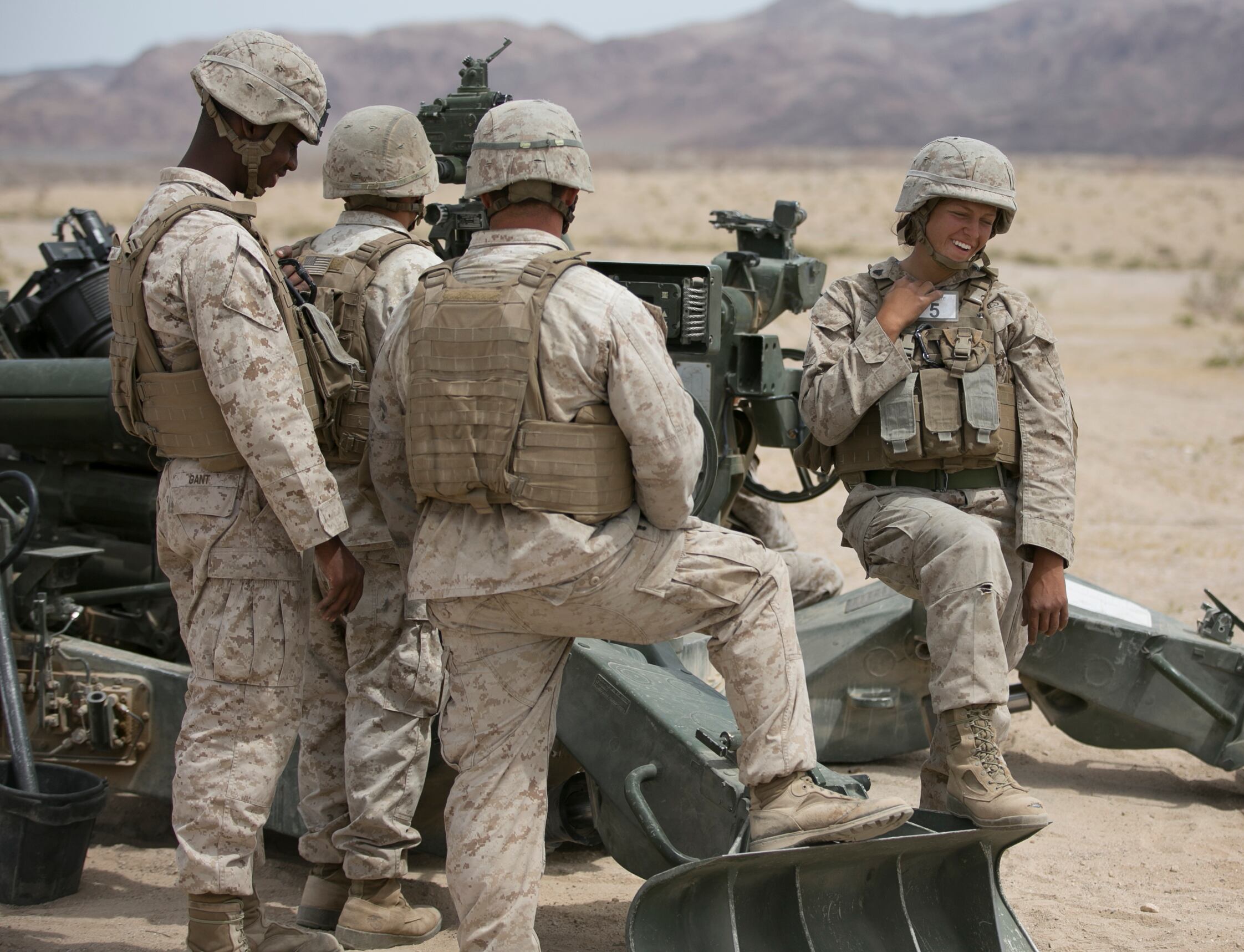Editor's note: This is the second in a three-part series on the Marine Corps' gender integrated task force.
TWENTYNINE PALMS, Calif. — Gun four was on the clock. The six crew members of the M777 howitzer's six crew members shouldered rounds from the 155mm gun, each weighing around 105 pounds. Test observers watched as the Marines trudged or loped 100 meters carrying each with the unwieldy cylindrical weights, then paused with an unweighted lap before completing the same trip again.
Several of the male Marines completed the task at a light jog, though their pace flagged noticeably on the second lap. Cpl. Allison Devries was not far behind, completing her circuits at a determined trot. Cpl. Carolina Ortiz, the gun's other female crew member, took a different approach. Eyes fixed straight ahead, cannon round supported on her left shoulder with both two hands, she finished the task at a paced walk, without faltering or attempting to speed up. Since this was a team activity, the clock stopped only when Ortiz, the last crew member, crossed the finish.
READ PART 1: All-female infantry team gets innovative
READ PART 3: Experiment could create stronger force
"I'm conserving my energy," she explained later as she sat by the gun, where that day her job involved cranking up the barrel to set the quadrant of fire and pulling the lanyard trigger to fire it on command. "I try to do a pace that's still challenging, because it's really soft sand and it swallows your feet, almost. I just go so that I'm not tired when I have to do my job. When we do the high-altitude [live-fire shoot], I've got to go as fast as I can. So that's when I'll bust out the guns."
At a slight 5-feet 3-inches, Ortiz, 27, was the crew's smallest shortest member of the day's gun crew. Her strategy, she said, involved channeling her strength into tight bursts of effort, allowing her to respond rapidly to commands as they came over the radio, turning the heavy crank to swing the gun into place. And the strategy worked: With all crew members swinging into action the moment the radio crackled to life, the "high-density female" howitzer, out of the six cannons in the day's assessment, was the fastest on the gun line all day long.
![GCEITF 29 Palms MWM 20150410[ID=26983217] ID=26983217](http://www.gannett-cdn.com/-mm-/73711ff29d50dfcf80bc2197e762b72a3a2958e3/c=145-0-1918-1333&r=115x86/local/-/media/2015/05/08/GGM/MilitaryTimes/635666860982594632-20150410-1MM5436.jpg) Within At the Marine Corps' Ground Combat Element Integrated Task Force, strategy becomes key when raw strength gets pushed to its limits. During an April embed with the unit, which was completing visit to the task force in April as it completed a series of ground combat arms assessments as part of the Pentagon's broader effort to open more career fields to women, it became clear there are no that simple answers when it comes to the question of gender integration would be hard to come by. The task force, which activated stood up last fall and now has roughly 200 male and 75 female volunteers organized into subordinate ground combat specialties, set out to determine gender-neutral physical standards for each specialty currently open only to men closed combat job.
Within At the Marine Corps' Ground Combat Element Integrated Task Force, strategy becomes key when raw strength gets pushed to its limits. During an April embed with the unit, which was completing visit to the task force in April as it completed a series of ground combat arms assessments as part of the Pentagon's broader effort to open more career fields to women, it became clear there are no that simple answers when it comes to the question of gender integration would be hard to come by. The task force, which activated stood up last fall and now has roughly 200 male and 75 female volunteers organized into subordinate ground combat specialties, set out to determine gender-neutral physical standards for each specialty currently open only to men closed combat job.
![GCEITF 29 Palms MWM 20150411[ID=27249355] ID=27249355](http://www.gannett-cdn.com/-mm-/92b03fef875e4392a94b50236594bc0d5d0bba64/c=104-0-2658-1920&r=115x86/local/-/media/2015/05/13/GGM/MarineCorpsTimes/635671272928563939-MAR-GCEITF-Infantry02.jpg) But the unit's findings of the unit will also will play a key role in informing recommendations the Marine Corps' commandant must make to the secretary of defense early at the beginning of next year. If he determines it's necessary, the commandant may recommend that certain specialties remain closed to women entirely, even as others open.
But the unit's findings of the unit will also will play a key role in informing recommendations the Marine Corps' commandant must make to the secretary of defense early at the beginning of next year. If he determines it's necessary, the commandant may recommend that certain specialties remain closed to women entirely, even as others open.
As the Marines edge closer to a decision point, it's evident many task force volunteers, particularly the female ones, are fighting to make a point about women's the abilities of women and to make more options available for those the ones who will come after them.
"This paves the road for the rest of the females who want to do this," said Lance Cpl. Brittany Dunklee, a volunteer in the light armored vehicle specialty, currently restricted to men only. "If you think you can do it, you can do it, male or female."
Devries, 21, also acknowledged she had come to the unit with "a passion and a belief" about the opportunities that should be available to female Marines.
But Ortiz, who was formerly a field radio operator stationed in Okinawa, admitted she came to the unit more out of curiosity: to see if a typical female Marine, like herself, had what it took to hold her own in combat arms.
"I wanted to know, if they took the average Joe — which is kind of my position, I'm not really an athlete or anything — I wanted to see if I could do it," she said.
After some six months training with the task force and another month of assessments, Ortiz feels that she has her answer.
"It's really challenging; I've never worked so hard in my life," she said. "It's not going to be easy, but if the will's there, I'm pretty sure [female Marines] can hack it."
The challenge for decision-makers lies in how different each of the closed combat arms fields are, from engineers to weapons to mechanized units. Each field is physically demanding, but some appear to be more easily within reach of the "average Joe" female Marine, as Ortiz put it.
At the task force's mechanized company, certain apparent obstacles specific to the size of the vehicles seemed to diminish as female volunteers began to work with the units. In the light armored vehicle platoon, in which crew members must work together to change 175-pound tires and haul a 200-pound simulated crewman casualty out of the vehicle to an evacuation point a distance away, volunteers acknowledged admitted there was a learning curve.

Photo Credit: John Bretschneider
Lance Cpl. Christopher Augello, 23, said he had devised a new method for using leverage to move the heavy tires after being assigned to an assessment with a shorter female volunteer several times in a row.
"We just found different ways to do things, the fastest and easiest way, so you're not putting so much stress on your body," Augello said. "Everybody's gotten more proficient at their jobs. I know what I have to do, and they know what they have to do."
On the question of whether the field should integrate, Augello said he was "pretty much neutral."

Lance Cpl. Julia Carroll helps carry "Cpl. Carl," a realistically weighted casualty dummy.
Photo Credit: Mike Morones/Staff
Past Beyond the learning curve, however, many volunteers felt ready to move into real-world integrated operations with their training.
"Now that we've been out here so long, nothing is much of a challenge anymore," said Pvt. Jordyn Ridgeway, 20, a volunteer with the amphibious assault vehicle platoon who had completed the day's assessment as a crew chief. "There's a couple different ways to do pretty much anything. You learn the tricks of the trade."
Cpl. Kelsey Darling, 20, another AAV volunteer, said she also believed the average female Marine could do the job.
"Just each person is unique, so it depends on if they want to do it or not," she said.

At the task force's infantry and weapons companies, an answer to the question of integration might be more complex.
Capt. Mark Lenzi, the commanding officer of Weapons Company, contended that the unit, which consists of machine gun, anti-armor and mortar platoons, had the most physically challenging of the ground combat tasks, a role that often required Marines to carry well over 100 pounds in combat gear load and weapons, with all the speed and maneuvering capability required of ground troops with a lighter load.
"If you weigh 115 pounds and you're carrying 160 pounds on a regular basis, there's a point at which things start to break down," he said. "We have studies that tell us that."

Marines line up to be weighed before an assessment. Researchers are collecting a host of data throughout the experiment.
Photo Credit: Mike Morones/Staff
Lenzi said the assessment was a boon to officers like him in that it would create minimum required standards to enter such a grueling and physically demanding job field. Without them, he said, he sometimes ended up with male Marines who just weren't up to the task. In that case, he said, a unit had really only two options: Give the Marine an administrative or clerking position, or work to move him laterally into another field.
"If you're five-six 5'6" and 120 pounds, you have virtually no chance of doing this job, whatsoever," Lenzi said.
Left unsaid was the fact that setting minimum height and weight criteria above that threshold would rule out a significant portion of the female Marine population — perhaps a majority.
Among Weapons Company's all-woman anti-armor team, several members of which have fought through injury to remain with the task force, opinions are mixed as to whether the Marines would choose this life for themselves if given the option after the task force.
Sgt. Danielle Beck, 29, said it would be difficult to move up into the field as a senior noncomissioned officer, having just learned the basics of training and readiness. But, she said, she knew more senior female Marines would be needed to facilitate the potential integration process.
"I do feel that for the younger generation coming in, they do need a female senior that's been there, just gone through the training, understands where they are mentally and physically," she said.
For Cpl. Janelle Lopez, another member of the four-woman team, the assessment had proved that being able to do the job and wanting to do it might not go hand-in-hand.

Cpl. Allison DeVries talks with fellow Marine volunteers.
Photo Credit: Mike Morones/Staff
DeVries, the female artillery volunteer who entered the assessment with "passion and belief," said she is leaving it with a thoughtful perspective and a nuanced viewpoint.
"I feel that my opinion on females in it is, if they can do it and the meet the standards, and standards aren't being lowered, then yes, females should be allowed to [serve in combat units]." she said. "But they also have to have the mental aspects to handle the ground combat side as well as the strength and physical abilities. And ... I feel that there are more that cannot than can."



